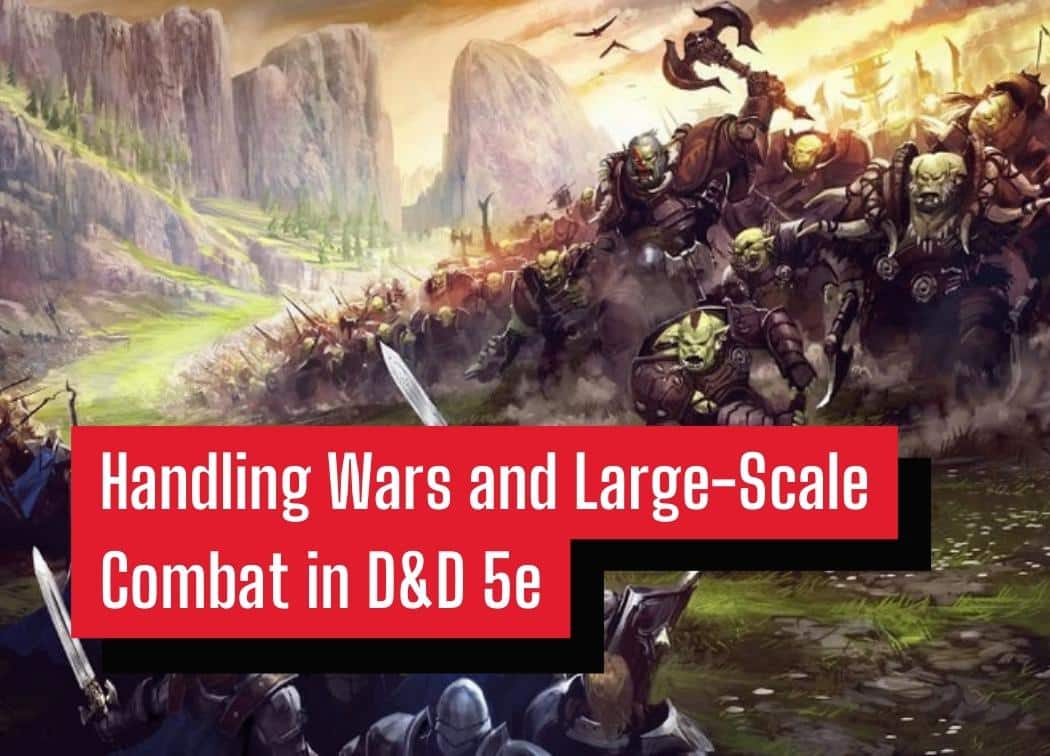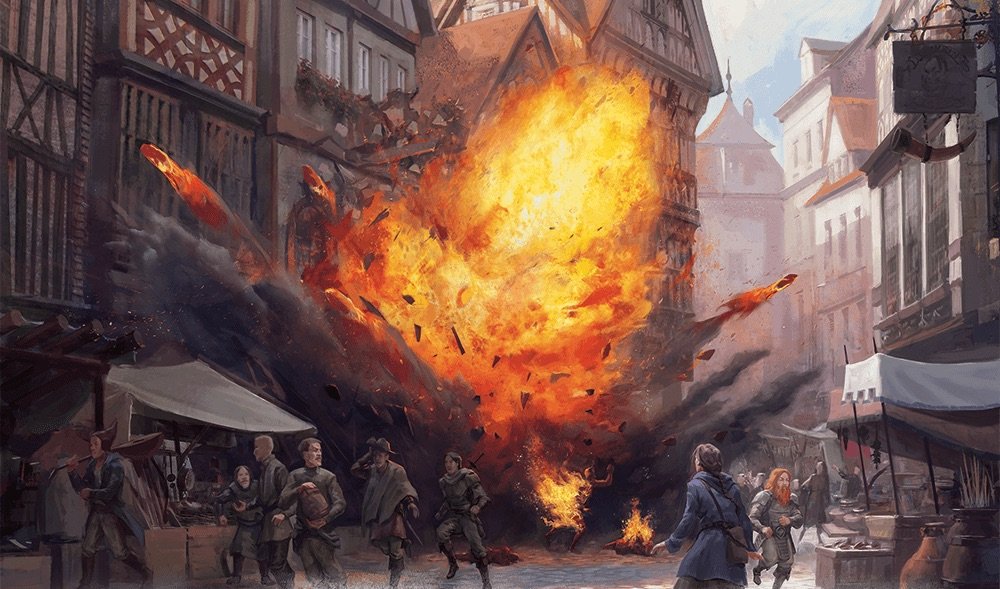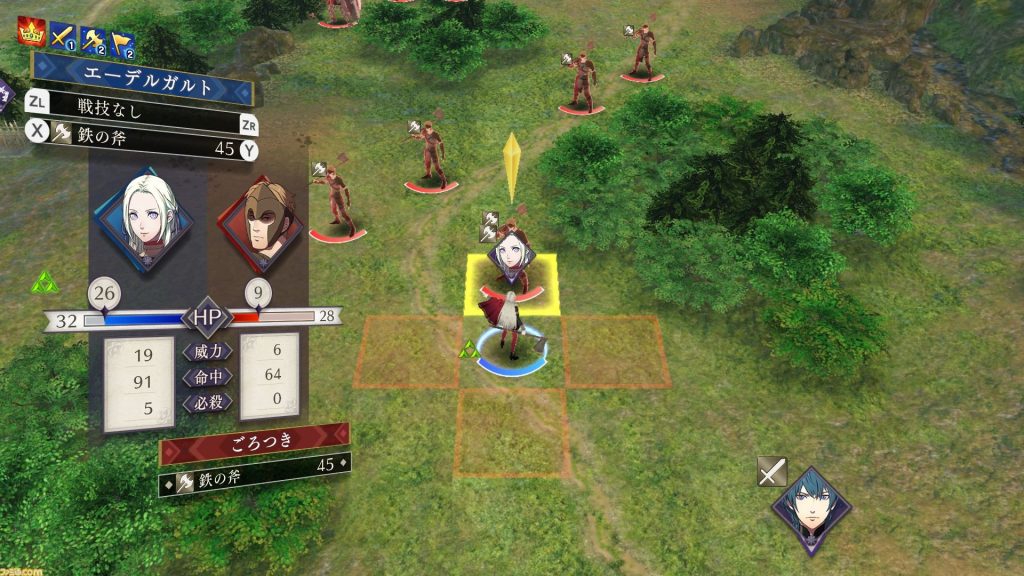Handling Wars and Large-Scale Combat in D&D 5e

Fantastic stories can come from wars or enormous battles. Heroes are made, villains are defeated, and friends are lost. Plot hooks galore can pop up on a battlefield! There’s just one problem. Large encounters with tons of moving pieces are not things that D&D 5e handles well.
There’s so much to keep track of like status conditions, action economy, and spells that having a lot of creatures in a combat encounter quickly grinds the game to a slow, lethargic pace. This can be challenging already for groups of 5-6 up against 5+ enemies.
Wars and other types of large-scale combat take this issue and crank it up to 11 if you were to run them as a regular encounter. Even if you group creatures up to speed up combat you’re still going to be rolling a ton of dice and positioning a lot of enemies as the DM. The players are going to get bored watching you roll dice against yourself for an entire session.

But for someone who has such a bone to pick with these types of encounters, most of my games do have at least one such story scene in a campaign. This is because I’ve completely changed the way I run war scenes in my D&D games so that they actually work with both the story and the gameplay.
The Problem with Large-Scale Combat
My number one issue with any encounter with lots of units on the field is that it slows down the game so much. If we were to run a war or skirmish as a single combat encounter it would be like running D&D 5e for an oversized group but like x100. What I mean is that it would be slow and boring.
It’s just not feasible to have that many pieces on the board at once in D&D. You’d probably be better off straight-up using a wargaming system to run your war scene in your campaign. But that’s a huge hassle just to play through a single session if your group isn’t familiar with said wargaming system already.
Could you find or make rules for running large-scale combat in D&D 5e? Absolutely. But that’s a huge amount of work, especially if you want to have something that feels balanced.
This is where my gripe with wars or big battles comes from. D&D 5e isn’t a system that handles this naturally and figuring out ways to do so will take a fair amount of time and effort if we want to get it “right”.
Yet I still want to actually have wars, skirmishes, etc. in campaigns. As I’ve said, they can be a fantastic addition to a good story. So that’s why I take what would be a large-scale combat encounter and turn it into what D&D is best known for. A dungeon!
Make Your Party the Heroes (or the Villains)!
The Fire Emblem series is a perfect example of what I mean by this. In the games, the lord character is usually the commander of an army. This army is mentioned in conversations and narrations, but the player doesn’t (usually) have a hand in controlling them. Instead, they control 10-12 main characters in each battle.
Your party is just that. They’re the protagonists, not the grunts. The grunts are offscreen fighting the opposing forces. The PCs will be instead focused on objectives that will have a major impact on the tide of the battle.

The point is, your party doesn’t need to be fighting in-line with the army. You don’t need to spend time rolling attacks for every grunt in the battle. Doing so would certainly make the players feel like they’re participating in a war, but it would also be boring as hell to watch you control both armies for 90% of the encounter.
The party may have to fight a couple of waves of grunts to get to the objective, but these can be treated as regular combat encounters in a dungeon. Hell, you could even line up the armies in such a way that it looks like a giant maze that the party needs to navigate through if you were so inclined.
Give the Party Actionable Objectives
As I said, I don’t run wars as wars in D&D. I run them like dungeons or strings of encounters. Each objective consists of a string of encounters that the party can complete, avoid, and maneuver their way through.
Objectives should be major events or stakes that can heavily impact the outcome of the battle. This is why I tend to wait until the party is at least around level 8-10 to run something like this. The party should be powerful heroes with the tools to make an impact on such an important event.
These objectives could be slaying an enemy commander, infiltrating the fortress to lower the drawbridge so the rest of the allied army can enter, or anything in-between. Give your war multiple elements that the party can interact with!
Write down some Grim Portents for each of these objectives. Basically, determine what will happen if the party does not complete these objectives. Will their allies sustain more casualties? Will the opposing force win? Each objective should have stakes that the party has to deal with.
Objectives don’t have to just be about preventing something bad from happening. You can also give the party objectives to give their allies leverage in the
Once the party completes or fails an objective you should narrate how the battle has been affected. Let the players feel the weight of their decisions, good or bad.
Coming up with objectives for the party is the easy part about prepping a war or battlefield scene. The challenging part is figuring out how to assign these objectives to the player as well as how to convey the consequences of not succeeding.
Assignments from Important NPCs
The most obvious solution for giving your players an objective is to have an important NPC straight-up tell them what to do. This could be a commander or officer giving the party a direct order, or it could be an ally telling the party about a major issue that the army is having.
This method works great for indecisive groups. Wars are fast-paced environments. The party won’t have all day to plan and prep how they’ll tackle the objective. They need to disable those catapults or slay the dragon torching their allies NOW!
The one downside to this method is that it does have the potential to make the party feel like the commander’s pawns. Be sure to have some optional objectives that the party can accomplish to help give the players some additional choices during the battle.
The PCs Call the Shots
Your party may be so renown that the higher-ups in the army let them have a very long leash. They’re not told what to do, they’re just expected to save the day.
Perhaps they’ll be given some vague objectives before the battle begins, but other than that the party has to determine what they can do to help their allies win.
This is a great option for a group that is familiar with the enemy forces, their tactics, and their intentions. They’ll probably know what to go after, who to take down, and how to do it better than any of their allied commanders and officers anyway, so why should they listen to them?
Conversely, the PCs may be the officers or commanders of the army. You could absolutely have them be giving orders and calling the shots and play out the scene based on their decisions. The party could still go off and tackle specific objectives, but their decisions and orders will also have an impact on the battle.
Show, Don’t Tell
If you’re going to play out a major battle scene you’re going to need to go all-out in your narration of the skirmish. The players need to know what the threats are, who is where, and of course, what they need to be doing. A vivid, but concise narration is crucial for this.
If an objective is truly going to have a major effect on the outcome of the battle you need to show your players why this is the case. Show the cannons ripping apart squads of allied soldiers and show the mages slinging lightning bolts at your air support.
This destruction will certainly alert the party that those two problems are something that needs to be quickly solved, and hopefully, they’ll realize that they’re just the people for the job.
This method of showcasing objectives is also handy if you are letting the players call the shots. Their characters should be able to deduce or see what the most pressing danger is in the battle if they are expected to be barking orders to the rest of the army.
Ability Checks
Alternatively, you can use ability checks to supplement the party looking around the battle for ways to assist their allies. For example, they could use history checks to recall the enemies’ famed tactics or a perception check to locate importantly enemy commanders that should be brought down.
I’d use ability checks as a way to supplement the three other methods I’ve already listed. Use ability checks as a way to move the scene along if the party is having a tough time figuring out what to do, or to give the party some extra information about their foes.
This is also a great option for giving the party’s skill aficionados a way to shine during what is probably going to be a combat-heavy session.
Conclusions
Wars make for excellent and exciting parts of a story. They can be a thrilling conclusion to a long campaign or a climax of an important story. They’re also riddled with potential plot hooks for the DM to throw at the party.
My problem with wars and large-scale combat encounters is that D&D 5e doesn’t handle these scenes very well. Nothing against the system, but it’s a system where combat encounters are designed for 3-6 players and about as many creatures. Multiplying these numbers even by 10 is going to break the system.
That’s why I insist on not having the PCs be grunts in the army during a large-scale battle. Have the battle be “off-screen” and the party is tackling major objectives that will aid in their allies winning the battle.
The party is too important to be fighting with the cannon fodder. Give them the opportunity to become the heroes of the war!

It’s a good way to do it; I’ve been working on adaptations the Dragon Age mass battle system for when my players are commanding the groups (or I just want the players to know the overall tide of the war). It means the players could be losing, but because their army is doing so well, they are saved! It could also mean that their army is overwhelmed and that they are at a disadvantage because the army is pulling back and they have to hole up in a nearby hiding place.
Yeah, that’s how both me and the one other person I’ve seen use a war (with the PCs taking a side, that is) as a major plot arc did it. PCs aren’t there to wade through hordes of CR 2 enemies, they’re there to take on the terrors nobody else in the army stands a chance against. They’re there for the dragons, the commanders, the evil rituals to turn the tide against the forces of good.